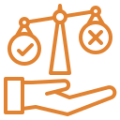The Performance Coaching Paradox
Many leaders fall into a reactive rather than proactive pattern when it comes to addressing performance improvement. This often shows up in the following ways:
- Focus on “fixing” poor performers and problems
- Leave high performers to themselves (and give them too much to do)
- Address deficits rather than build on strengths
- Practice performance management instead of true coaching
This approach is problematic for several reasons:
- Top performers can get overlooked and feel undervalued
- High performers might seek opportunities elsewhere if not challenged
- The organization misses opportunities to leverage team member strengths
- Overall team productivity suffers from the focus on eliminating problems rather than pursuing opportunities
Move from Discipline to Development
While discipline (getting rid of poor performance) has its place in addressing performance that falls below minimum expectations, coaching (improving already good performance) should be your primary tool for development. Here’s how to strike the right balance:
- Set Clear Expectations: Ensure team members understand both minimum performance standards and growth opportunities.
- Look for Opportunities to Be Positive: Finding negatives is easy. Noticing and commenting on the positive often takes effort and intentionality.
- Use Inclusive Language: More “us” and “we” than “you” and “they” in your conversations.
- Practice Active Listening: Talk less, listen more, and engage team members with thoughtful, open-ended questions.
- Emphasize Growth and Development over Deficit Correction: Frame challenges and gaps as opportunities for learning and growth rather than as failures requiring correction.
Understanding Compliance vs. Commitment
With compliance-focused performance discussions, you might get base-level cooperation and minimum performance – when you’re around to see and comment on performance. Team members will likely follow orders, do what they must to stay out of trouble, and their engagement will remain superficial. You will not achieve true commitment to your larger business objectives.
You cannot require your employees to be creative and engaged. You can only encourage and support them towards that goal. It’s up to them whether they bring their full energy to work with them. When you coach in a way that encourages your employees to creatively solve problems, you gain commitment, and with commitment, you achieve something far more valuable – discretionary effort. When people exert discretionary effort, they start choosing to do things that they don’t have to do, and they move beyond bare minimum performance to excellence.
The Power of Coaching for Commitment
Coaching for compliance focuses on fixing perceived problems – telling people to do more of this or less of that. This approach often triggers resistance because it crushes hope and robs energy.
A better approach is coaching for commitment. This approach creates an environment focused on growth and development. Coaching for commitment involves the following:
- More listening and less talking
- More questions and fewer directives
- More care for the person and less disregard for their frustrations and concerns
- More inviting team members to solve problems and less of you solving everything
Shift Your Coaching Focus
The best coaches spend at least 50% of their time coaching top performers. Why? Because top performers offer the following advantages:
- Already get more done and will achieve even more with good guidance and support
- Represent the future of your organization
- Thrive on coaching and actively want it
- Require less of your effort to become excellent than poor performers demand of you to achieve minimum compliance
Support Your Top Performers
Here’s how to effectively coach high performers:
- Learn their personal goals and aspirations
- Show appreciation for their contributions rather than expecting it as “that’s what they should be doing”
- Help them focus on and enhance their strengths
- Provide resources, tools, and skills for growth
- Offer progressively more challenging assignments
- Create opportunities for them to share their experience through mentoring opportunities
The Bottom Line
The choice between compliance and commitment isn’t about ignoring problems, fluff, and fake positivity – it’s about creating a culture that celebrates excellence while supporting growth at all levels. Yes, you must address poor performance when necessary, and you’ll get more return on your coaching effort by investing in your top performers and rewarding good performance rather than punishing the poor performance of the less-than-stellar ones.
This shift in focus has an additional and often missed side benefit. When you choose to focus on helping top performers become even better, it often invites less stellar performers to improve as you create an overall more hopeful and positive environment.
Your Role as a Leader
Consider these questions:
- How do you allocate your coaching time between high and low performers?
- Are you catching people doing things right, or only pointing out mistakes?
- Are you helping your best people become even better?
- Have you created an environment where excellence is noticed and nurtured rather than accepted without recognition?
When you make the shift from coaching for compliance to coaching for commitment, every member of your team will get better, and you’ll be less stressed.

























